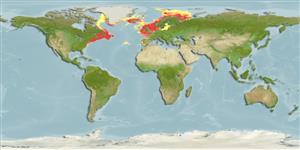Classification / Names
Common names from other countries
Main reference
Size / Weight / Age
Max length : 61.0 cm TL male/unsexed; (Ref. 58426); 42.9 cm SL (female); max. published weight: 9.5 kg (Ref. 4701); max. published weight: 9.5 kg; max. reported age: 13 years (Ref. 54207)
Environment
Marine; benthopelagic; oceanodromous (Ref. 51243); depth range 0 - 868 m (Ref. 58496), usually 50 - 150 m (Ref. 4701)
Climate / Range
Polar, preferred 6°C (Ref. 107945); 80°N - 32°N, 95°W - 49°E
Distribution
Western Atlantic: Nunavut, Hudson Bay to James Bay and Labrador in Canada to New Jersey in USA; rarely to Chesapeake Bay in USA and Bermuda. Eastern Atlantic: Barents Sea, Iceland and Greenland to Spain (Ref. 4701).
Countries | FAO areas | Ecosystems | Occurrences | Introductions
Short description
Dorsal
spines
(total): 5 - 9;
Dorsal
soft rays
(total): 9-11;
Anal
spines: 0;
Anal
soft rays: 9 - 10;
Vertebrae: 28 - 29. First dorsal fin present but covered by thick layer of skin forming a characteristic high crest with embedded spines. Bony tubercles present, arranged in 3 widely separated rows of large flattened tubercles on each side of body. Gill openings large, extend- extending below level of upper pectoral fin ray. Pyloric present 36-79. Ventral sucking disc formed by the modified pelvic fin (Ref. 232).
IUCN Red List Status (Ref. 115185)
Threat to humans
Harmless
Human uses
Fisheries: commercial; bait: usually
Tools
Special reports
Download XML
Internet sources
Estimates of some properties based on models
Phylogenetic diversity index
PD50 = 1.0000 many relatives (e.g. carps) 0.5 - 2.0 few relatives (e.g. lungfishes)
Trophic Level
3.9 ±0.0 se; Based on diet studies.
Resilience
Low, minimum population doubling time 4.5 - 14 years (K=0.12; tm=3-5; tmax=13; Fec=100,000)
Vulnerability
Moderate to high vulnerability (47 of 100)
Price category
